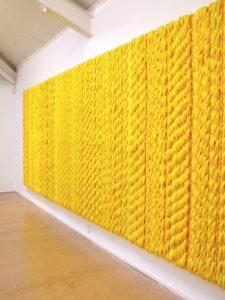Plastic has gotten away. It began in 1862 when Alexander Parkes unveiled Parkesine – a material derived from cellulose that could be moulded when heated and retained its shape when cool. But it was with the invention of Bakelite in 1907 that plastic really took off. It was a revolutionary new material destined to solve all sorts of industrial and domestic problems. Lauded for its flexibility, and its role in saving ‘natural’ resources from plunder, by 1976 it had evolved into the worlds’ most used material. Recent research has shown that plastic can exude a chemical which mimics synthetic oestrogen – a hormone which is a significant factor in the growth and multiplication of cancer cells. In Rogue Plastic the artists’ formal and aesthetic treatment of this ubiquitous product hides its true nature.
Paul McInnes pays tribute to the Danish architect and interior designer Verner Panton who, in 1960, invented the first chair to be moulded from a single piece of plastic. McInnes’ Freize, using white plastic ice cube trays, is domestic and regular, but there is something awry. Here the Verner Panton interior is white bleached like a shadow or the aftermath of a flash bulb going off. This flash of white, this slice of life, is the advertising executives sweetest dream of plastic consumption.
David Sequeira’s obsession with collecting and cataloguing other people’s discards makes him waste management a pin up boy. Zen Picnic is life, the universe, wholeness and sustenance delivered to you on a plastic platter. His Constructivists are GO robots are ingenious assemblages of bottle tops and lids, all of them objects cast adrift from their original purpose and from their other halves
 Using polypropylene and nylon rope imported form Spain, Dani Marti takes advantage of plastic rope’s pliancy and extraordinary colour range to weave portraits of people he knows. For him, ropes are carriers of strength and sensuality. The distinct repeat patterns in these works are like a type of morse code, or a string of DNA. There is an act fo bondage inferred as Dani captures the essence of his subject in the rope. Mad Babe is all at once contained and wild. On initial viewing there seems to be no recognisable pattern but slowly a sense of this mad babe emerges. The pattern from the weave is embellished by flashes of colour in the rope, which are the trademark of the manufacturing company. The triptych George is a portrait of an architect who is obsessed with the colour yellow. Here, every type of yellow in every diameter and texture of rope has been added to the palette to capture George’s nature. The wrap in George is a form of plastic tubing used to farm mussels. There is a smooth play on words here for a ‘warp’ is also a ‘rope used to towing or attached to a trawl net.
Using polypropylene and nylon rope imported form Spain, Dani Marti takes advantage of plastic rope’s pliancy and extraordinary colour range to weave portraits of people he knows. For him, ropes are carriers of strength and sensuality. The distinct repeat patterns in these works are like a type of morse code, or a string of DNA. There is an act fo bondage inferred as Dani captures the essence of his subject in the rope. Mad Babe is all at once contained and wild. On initial viewing there seems to be no recognisable pattern but slowly a sense of this mad babe emerges. The pattern from the weave is embellished by flashes of colour in the rope, which are the trademark of the manufacturing company. The triptych George is a portrait of an architect who is obsessed with the colour yellow. Here, every type of yellow in every diameter and texture of rope has been added to the palette to capture George’s nature. The wrap in George is a form of plastic tubing used to farm mussels. There is a smooth play on words here for a ‘warp’ is also a ‘rope used to towing or attached to a trawl net.
Jane Barney